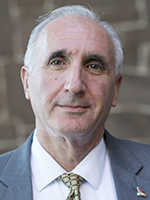Peters Discusses Highlights of Wesleyan’s Operating Budget

Wesleyan’s operating budget in the last fiscal year included a total of $206 million in expenditures, with $210 million in revenue. Most of the university’s revenue (68 percent) comes from student charges, while the endowment, private gifts and government grants account for most of the rest. The operating budget lies behind everything Wesleyan does, and we’ve asked Nate Peters, vice president for finance and administration, to explain some of its highlights:
Q: What is Wesleyan’s projected total operating expenditure in the current fiscal year, and what has been our annual rate of increase? What are the primary drivers of that increase?
A: Total expenditures are projected at $214 million. Our cost trends are in the +4 percent range. Compensation (salaries and benefits) is the biggest driver – whether for existing faculty and staff or for new hires. Higher education is a labor-intensive enterprise. We are watching our medical benefits as they have dramatically trended upwards during the past several years. We are also making some investments in additional faculty, financial aid and major maintenance as outlined in Wesleyan’s strategic plan Beyond 2020.
Q: Are we more dependent upon tuition revenue than many of our peers? Why? What are the implications of this?
A: Yes, we are more dependent than many of our peers on student charges (tuition, room and board) revenue. Over two-thirds of Wesleyan’s revenue comes from this source. This is why enrollment is so important to our finances. Schools with larger endowments will rely less on student charges. For example, Williams relies on its endowment for about 50 percent of its revenue and only 35 percent on student charges.
Q: Explain what the discount rate is and why we hope to increase it. How does our rate compare to our peers’ rates?
A: The discount rate is the amount of financial aid you spend divided by the amount of tuition you would collect if everyone paid full price. Think of it as buying a car and the sticker price is $30,000 but you only pay $22,500. The $7,500 you did not pay (in this case not based on financial need but based on your negotiating skills or having Olga Bookas negotiate for you!) divided by the $30,000 sticker price gives you a 25 percent discount rate.
Currently, we do not collect more than a third of our tuition revenue. Thanks in large part to our successful fundraising campaign, over the next four years we are increasing the discount rate from 32 percent to 36 percent as outlined in our strategic plan. Increasing the discount rate means we can provide more financial aid to more students, which promotes economic diversity.
Peers are more in the mid-40 percent range. Again, they have larger endowments. Our endowment spending is $40 million annually and we “spend” over $55 million on financial aid, so even if all our endowment spending went for financial aid, it would not offset all the lost revenue. We provide a large amount of financial aid given the resources we have available.
Q: Explain the $250 million Century Bond and the rationale behind it. Has it had an impact on the operating budget?
A: In late spring 2016, the bond market provided an opportunity for us to acquire long-term fixed debt at historically very low interest rates. The Century Bond enabled us to significantly reduce debt service costs in the next few decades, to free up working capital, and to plan for debt repayment 100 years from now with relatively small start-up principal.
We borrowed $250 million at a fixed rate of 4.781 percent (below our 5 percent target goal) and refinanced almost all our debt. We ended up with $45 million in operating funds currently invested in the endowment that can later be used for facilities projects. Putting it in the endowment allows it to grow and increases our resource base until the time we need it.
Q: Will the new tax legislation or any other changes at the federal level have any impact on our operating budget?
A: The major issues potentially affecting faculty, staff and students were mostly removed from the final enacted tax bill. There are some small changes that we continue to analyze but have to wait for final IRS guidance to measure effects. We will have to see if the higher standard deduction has an impact on fundraising because there will be fewer donors who itemize and deduct gifts from their taxes. However, I believe most people give to Wesleyan because they have a fondness, even a passion, for Wesleyan and appreciate what it has done for them, or for their children or relatives.
The bill also mandates a 1.4 percent endowment tax on investment earnings for institutions with an endowment per student of $500,000 or more. While at this time it does not affect Wesleyan, it does open the door to future taxation.
Q: Wesleyan appears to be financially stable, with strong fundraising and endowment support. As you look ahead, do you see any red flags?
A: The cost of higher education remains a hot topic. Critical to Wesleyan’s financial stability is making sure we continue to provide a high-value educational experience to all our students.

